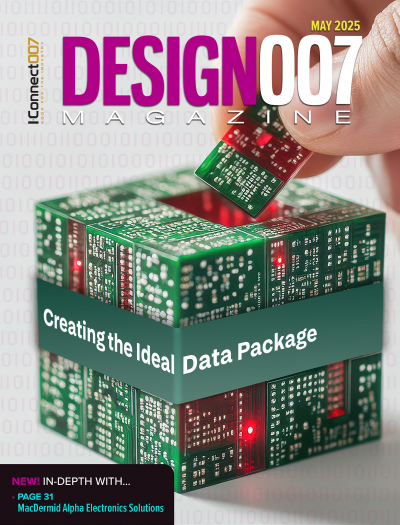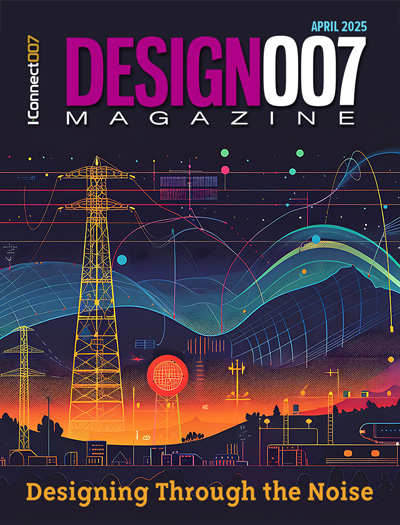-

-
News
News Highlights
- Books
Featured Books
- design007 Magazine
Latest Issues
Current Issue
All About That Route
Most designers favor manual routing, but today's interactive autorouters may be changing designers' minds by allowing users more direct control. In this issue, our expert contributors discuss a variety of manual and autorouting strategies.

Creating the Ideal Data Package
Why is it so difficult to create the ideal data package? Many of these simple errors can be alleviated by paying attention to detail—and knowing what issues to look out for. So, this month, our experts weigh in on the best practices for creating the ideal design data package for your design.

Designing Through the Noise
Our experts discuss the constantly evolving world of RF design, including the many tradeoffs, material considerations, and design tips and techniques that designers and design engineers need to know to succeed in this high-frequency realm.
- Articles
- Columns
- Links
- Media kit
||| MENU - design007 Magazine
iCD Introduces New Materials Planner Software
July 2, 2018 | ICDEstimated reading time: 1 minute
In-Circuit Design Pty Ltd (iCD), Australia, developer of the iCD Design Integrity software, has released the new iCD Materials Planner software to add to the Stackup Planner functionality. This will be rolled out to iCD support customers as an update to their current software.
The Dielectric Materials Library, which complements the iCD Stackup Planner, has
- Over 33,000 rigid and flexible materials up to 100GHz
- Produced by over 60 different manufacturers
- Containing over 700 series of materials
So, it is often a daunting task to ascertain which is the best material for an application. The iCD Materials Planner allows you to compare dielectric materials based on manufacturer, fabricator, frequency, dissipation factor (loss) and dielectric constant. This enables the designer to make an informed decision on which material is best for his application.
Generally the selection metric, for dielectric materials, is the amount of loss that a transmission line can tolerate and this is proportional to the frequency and rise time of the signals. The iCD Materials Planner is subdivided into five default TABs which gives the novice high-speed PCB designer a heads-up as to what to select for his application.
- Ultra Low Loss (Df ≤ 0.005)
- Low Loss (0.005 < Df < 0.010)
- Mid Loss (0.010 < Df < 0.015)
- Standard Loss (0.015 < Df < 0.02)
- Basic FR-4 (Df ≥ 0.02)
This is similar to a typical competitive analysis that a material manufacturer may present for, say, Isola vs Ventec and Rogers, but it is far more comprehensive, with over 60 vendors and 700 series of materials to choose from. Alternatively, a profile for each PCB fabricator that you usually deal with can be set up. This will display the complete range of materials that each Fab shop stocks ranging from basic FR-4 to low loss materials. This also enables the comparison of competitive Fab shop capabilities.
Watch below for a quick demonstration video of the iCD Materials Planner:
About In-Circuit Design Pty Ltd
In-Circuit Design Pty Ltd, based in Australia, developer of the iCD Design Integrity software incorporating the iCD Stackup, PDN and CPW Planner software, is a PCB Design Service Bureau and specialist in board level simulation. For further information or to download a free evaluation of the software, please click here.
Suggested Items
DownStream Acquisition Fits Siemens’ ‘Left-Shift’ Model
06/26/2025 | Andy Shaughnessy, I-Connect007I recently spoke to DownStream Technologies founder Joe Clark about the company’s acquisition by Siemens. We were later joined by A.J. Incorvaia, Siemens’ senior VP of electronic board systems. Joe discussed how he, Rick Almeida, and Ken Tepper launched the company in the months after 9/11 and how the acquisition came about. A.J. provides some background on the acquisition and explains why the companies’ tools are complementary.
Elementary Mr. Watson: Retro Routers vs. Modern Boards—The Silent Struggle on Your Screen
06/26/2025 | John Watson -- Column: Elementary, Mr. WatsonThere's a story about a young woman preparing a holiday ham. Before putting it in the pan, she cuts off the ends. When asked why, she shrugs and says, "That's how my mom always did it." She asks her mother, who gives the same answer. Eventually, the question reaches Grandma, who laughs and says, "Oh, I only cut the ends off because my pan was too small." This story is a powerful analogy for how many PCB designers approach routing today.
Siemens Turbocharges Semiconductor and PCB Design Portfolio with Generative and Agentic AI
06/24/2025 | SiemensAt the 2025 Design Automation Conference, Siemens Digital Industries Software today unveiled its AI-enhanced toolset for the EDA design flow.
Cadence AI Autorouter May Transform the Landscape
06/19/2025 | Andy Shaughnessy, Design007 MagazinePatrick Davis, product management director with Cadence Design Systems, discusses advancements in autorouting technology, including AI. He emphasizes a holistic approach that enhances placement and power distribution before routing. He points out that younger engineers seem more likely to embrace autorouting, while the veteran designers are still wary of giving up too much control. Will AI help autorouters finally gain industry-wide acceptance?
Beyond Design: The Metamorphosis of the PCB Router
06/18/2025 | Barry Olney -- Column: Beyond DesignThe traditional PCB design process is often time-consuming and labor-intensive. Routing a complex PCB layout can consume up to 30% of a designer’s time, and addressing this issue is not straightforward. We have all encountered this scenario: You spend hours setting the constraints and finally hit the Go button, only to be surprised by the lack of visual appeal and the obvious flaws in the result.


